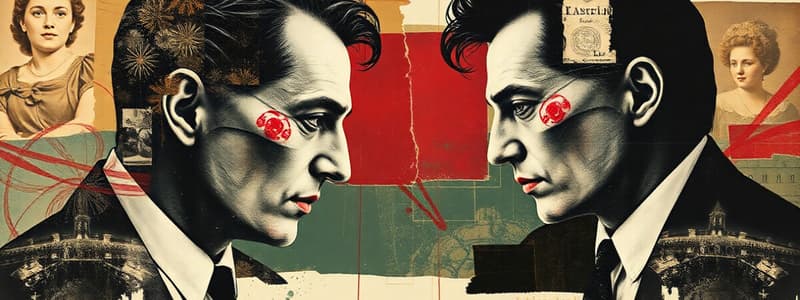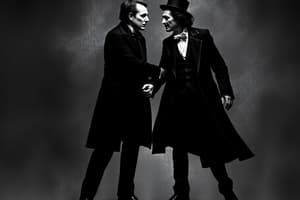Podcast
Questions and Answers
Robert Louis Stevenson wrote The Strange Case of Dr. Jekyll and Mr. Hyde to explore the conflict between good and evil within humans.
Robert Louis Stevenson wrote The Strange Case of Dr. Jekyll and Mr. Hyde to explore the conflict between good and evil within humans.
True (A)
An allusion is a distortion of the senses to give the impression of something that is not real.
An allusion is a distortion of the senses to give the impression of something that is not real.
False (B)
In the story, Utterson mentions 'Cain's heresy' in reference to his relationship with his brother.
In the story, Utterson mentions 'Cain's heresy' in reference to his relationship with his brother.
False (B)
The phrase 'am I my brother’s keeper?' comes from the story of Cain and Abel.
The phrase 'am I my brother’s keeper?' comes from the story of Cain and Abel.
The story focuses primarily on exciting tales of horror and murder.
The story focuses primarily on exciting tales of horror and murder.
Stevenson's writing reflects a Victorian perspective on the moral obligations of individuals.
Stevenson's writing reflects a Victorian perspective on the moral obligations of individuals.
The heresy described in the text promotes active intervention in the lives of others.
The heresy described in the text promotes active intervention in the lives of others.
Utterson the lawyer is described as cold, scanty and lighthearted in discourse.
Utterson the lawyer is described as cold, scanty and lighthearted in discourse.
Mr. Hyde is considered a flat character with little complexity to his motivations.
Mr. Hyde is considered a flat character with little complexity to his motivations.
The incident at the window is one of the rising action events in the story.
The incident at the window is one of the rising action events in the story.
In Chapter 8, Poole and Utterson find Mr. Hyde alive and well in Dr. Jekyll's study.
In Chapter 8, Poole and Utterson find Mr. Hyde alive and well in Dr. Jekyll's study.
Utterson enjoys the theatre and regularly attends plays.
Utterson enjoys the theatre and regularly attends plays.
Utterson is described as a man who is lighthearted and always smiling.
Utterson is described as a man who is lighthearted and always smiling.
Stevenson tells the story mainly from a third-person limited point of view.
Stevenson tells the story mainly from a third-person limited point of view.
The last two chapters of the story are told from Dr. Jekyll’s first-person point of view.
The last two chapters of the story are told from Dr. Jekyll’s first-person point of view.
A round character has a simplistic personality with no contradictions.
A round character has a simplistic personality with no contradictions.
Dynamic characters undergo significant changes in the story.
Dynamic characters undergo significant changes in the story.
Utterson dranks gin when he was alone to indulge his taste for vintages.
Utterson dranks gin when he was alone to indulge his taste for vintages.
Mr. Enfield's perspective is an example of first-person point of view.
Mr. Enfield's perspective is an example of first-person point of view.
Stevenson used multiple points of view throughout the entire novella.
Stevenson used multiple points of view throughout the entire novella.
The writing on the wall is referenced in relation to Babylonian King Belshazzar’s feast.
The writing on the wall is referenced in relation to Babylonian King Belshazzar’s feast.
Static characters experience significant changes just like dynamic characters.
Static characters experience significant changes just like dynamic characters.
Flashcards
What is an allusion?
What is an allusion?
A passing reference to a historical or literary figure, event, or piece of work.
Cain's Heresy
Cain's Heresy
Turning away from loved ones in need and not caring for their well-being.
Not being your brother's keeper
Not being your brother's keeper
The belief that it is not necessary to intervene in the affairs of others, even when they are in trouble.
How does Stevenson use sensory details in his descriptions?
How does Stevenson use sensory details in his descriptions?
Signup and view all the flashcards
How does Stevenson use characterization to reveal inner conflicts?
How does Stevenson use characterization to reveal inner conflicts?
Signup and view all the flashcards
How does Stevenson use figurative language to evoke an emotional response?
How does Stevenson use figurative language to evoke an emotional response?
Signup and view all the flashcards
What is Stevenson's purpose in writing 'The Strange Case of Dr. Jekyll and Mr. Hyde'?
What is Stevenson's purpose in writing 'The Strange Case of Dr. Jekyll and Mr. Hyde'?
Signup and view all the flashcards
First-person Point of View
First-person Point of View
Signup and view all the flashcards
Third-person Limited Point of View
Third-person Limited Point of View
Signup and view all the flashcards
Round Character
Round Character
Signup and view all the flashcards
Flat Character
Flat Character
Signup and view all the flashcards
Dynamic Character
Dynamic Character
Signup and view all the flashcards
Static Character
Static Character
Signup and view all the flashcards
Crisis/Turning Point
Crisis/Turning Point
Signup and view all the flashcards
Foreshadowing
Foreshadowing
Signup and view all the flashcards
Exposition
Exposition
Signup and view all the flashcards
Study Notes
Stevenson's Strange Case of Dr. Jekyll and Mr. Hyde - Study Notes
-
Purpose of the Story: Stevenson intended to explore the coexistence of good and evil within humanity, not just create a horror story.
-
Allusion in Chapter 1: The narrator uses an allusion to Cain and Abel, highlighting the idea of not being a "brother's keeper", urging readers to think about the difficult choices when dealing with people in trouble.
-
Point of View (POV): The story primarily uses third-person limited POV, focusing on Utterson's thoughts and feelings but limiting the reader's access to other characters' inner lives. Later chapters shift to first-person POV (e.g., Lanyon's and Jekyll's accounts). This mixture adds depth.
-
Excerpt from Chapter 1 (POV): The opening paragraph presents a third-person limited POV, detailing Utterson's character through observations and internal thoughts.
-
Example of First-Person POV: A later quote from the text offers an example of first-person POV (Enfield's perspective).
-
Round vs. Flat Characters: Round characters possess complex personalities with varied motivations, needs, and values, unlike flat characters with simple, one-dimensional personalities.
-
Mr. Utterson as a Round Character: Utterson is presented as a complex figure with internal contradictions, foreshadowing conflicts and decisions throughout the story. For example, his reluctance shown in the text to be involved, despite his concern.
-
Mr. Hyde as a Flat Character: Mr. Hyde is portrayed as a straightforward antagonist with cruel and uncaring motivations.
-
The Story's Crisis (Chapter 8): The crisis point occurs in Chapter 8, marking the apex of rising action, where characters confront the main threat, leading to a decisive turning point. In this instance, a confrontation involving Poole and Utterson directly leads to a significant event.
-
Suspenseful Atmosphere: The narrator builds suspense by describing the atmosphere and setting before the crisis in Chapter 8, further heightening the tension.
Studying That Suits You
Use AI to generate personalized quizzes and flashcards to suit your learning preferences.
Description
Explore the key themes, allusions, and narrative techniques in Stevenson's Strange Case of Dr. Jekyll and Mr. Hyde. This quiz offers a comprehensive overview of the text, focusing on the coexistence of good and evil, character POVs, and significant literary elements. Perfect for students looking to deepen their understanding of this classic work.




